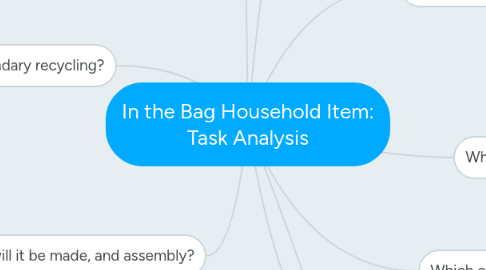
1. How will you check and ensure quality?
1.1. Law and legislation can be used to regulate sustainable practices in the context of the larger industry.
1.1.1. Manufacturers can use tools such as QC, QA and TQM to ensure quality of their products.
1.2. Material quality can be evaluated by checking brands, cross-evaluating products against similar models and inspecting items.
1.3. We will ensure and check quality in our product itself by conducting our own QA assessments, incorporating time for evaluation into our plan in objective B, consulting with our TG on their opinions and maximising our time and resources.
1.3.1. Attention to detail, patience and unrestrained effort heighten the quality and finish of products.
1.3.2. Regular testing and evaluations allows designers to address errors before they evolve into a larger problem.
2. What is secondary recycling?
2.1. There are three types of recycling.
2.1.1. Primary recycling is when a product is recycled and then used without changing it in anyway, probably for the same purpose. It may be thought of as secondhand use.
2.1.2. In secondary recycling, a product is changed or altered to be used in another way, but it's alteration in no way involves the use of chemicals.
2.1.3. Furthermore, in tertiary recycling a product is broken down using a chemical process and turned into a totally new product.
3. How will it be made, and assembly?
3.1. Our product will be made using tools avail be in the PD classroom.
3.1.1. A sewing expert will be available to help us in the process of assembling selected fabrics into a cohesive product.
3.1.2. Materials will be cut, coloured and otherwise altered as necessary.
3.1.3. Other fittings may be attached using glues or by way of sewing.
4. How will it effect the environment?
4.1. Our goal is to make a bag that has as little an effect on the environment as possible.
4.1.1. The bag will be made from recycled materials.
4.1.2. We will consider the disassembly/disposal bag with relevance to the environment.
4.1.2.1. If the product falls into our possession after production we will ensure that it is either reused, redistributed or recycled after we are done with it.
4.1.3. We intend to continue learning about the processes we will be subjecting our textiles to in the future to reduce harmful effects.
4.2. Our product should contribute to environmental sustainability and encourage others, (most specifically, us and our families) to continue to consume sustainable products, minimising our future impact on the environment.
5. Who will it be for?
5.1. Our TG is our immediate families and ourselves. .
5.1.1. We will be surveying them in Strand 2 and analysing the data we receive to create a product that has been individualised to suit their collective preferences and our own tastes
6. What textures/patterns?
6.1. Textures and pattens will be selected with TG feedback and viability in the context of the chosen feasible design in mind.
6.1.1. For reference to the fashion industry one large trend which is expected to dominate 2016 is athlesuire, which favours matte, un-patterned bags. Silhouettes, versatility and practicality are emphasised.
7. What components/fastenings?
7.1. Components and fastening will be specific to the chosen feasible design.
7.1.1. Some sort of latch, buttons, a handle/strap, drawstring and/or zipper may be incorporated.
8. What materials?
8.1. All materials must be recycled.
8.1.1. We could use materials made available by Mr. AI in the PD classroom
8.1.2. Used clothing from our homes which have reached the end of their life cycles will be evaluated.
8.1.3. Materials found at second hand shops and other alternatives may also be considered for use.
9. Which colours?
9.1. Again, aesthetics will be left largely to the opinions of the TG.
9.1.1. As spring approaches, Pantone colour forecasts predict that neutrals and pastels will trickle through markets.

